NCERT Solution for Class 10 Mathematics Chapter 3 - Pairs of Linear Equations in Two Variables Page/Excercise 3.1
Question 1
Aftab tells his daughter, "Seven years ago, I was seven times as old as you were then. Also, three years from now, I shall be three times as old as you will be." (Isn' this interesting?) Represent this situation algebraically and graphically.
Solution 1
Let the present age of Aftab and his daughter be x and y respectively.
Seven years ago,
Age of Aftab = x - 7
Age of his daughter = y - 7
According to the given condition,

Three years hence,
Age of Aftab = x + 3
Age of his daughter = y + 3
According to the given condition,

Thus, the given conditions can be algebraically represented as:
x - 7y = -42
x - 3y = 6

Three solutions of this equation can be written in a table as follows:
Seven years ago,
Age of Aftab = x - 7
Age of his daughter = y - 7
According to the given condition,

Three years hence,
Age of Aftab = x + 3
Age of his daughter = y + 3
According to the given condition,

Thus, the given conditions can be algebraically represented as:
x - 7y = -42
x - 3y = 6
Three solutions of this equation can be written in a table as follows:
| x | -7 | 0 | 7 |
| y | 5 | 6 | 7 |
Three solutions of this equation can be written in a table as follows:
| x | 6 | 3 | 0 |
| y | 0 | -1 | -2 |
The graphical representatino is as follows:

Concept insight: In order to represent a given situation mathematically, first see what we need to find out in the problem. Here, Aftab and his daughter's present age needs to be found so, so the ages will be represented by variables x and y. The problem talks about their ages seven years ago and three years from now. Here, the words 'seven years ago' means we have to subtract 7 from their present ages, and 'three years from now' or 'three years hence' means we have to add 3 to their present ages. Remember in order to represent the algebraic equations graphically the solution set of equations must be taken as whole numbers only for the accuracy. Graph of the two linear equations will be represented by a straight line.
Question 2
The coach of a cricket team buys 3 bats and 6 balls for Rs 3900. Later, she buys another bat and 2 more balls of the same kind for Rs 1300. Represent this situation algebraically and geometrically.
Solution 2
Let the cost of a bat and a ball be Rs x and Rs y respectively.
The given conditions can be algebraically represented as:
3x + 6y = 3900
x + 2y = 1300

Three solutions of this equation can be written in a table as follows:
The given conditions can be algebraically represented as:
3x + 6y = 3900
x + 2y = 1300
Three solutions of this equation can be written in a table as follows:
| x | 300 | 100 | -100 |
| y | 500 | 600 | 700 |
Three solutions of this equation can be written in a table as follows:
| x | 300 | 100 | -100 |
| y | 500 | 600 | 700 |
The graphical representation is as follows:
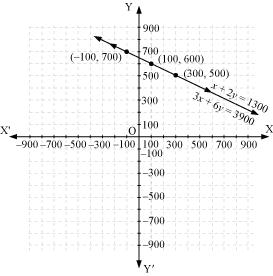
Concept insight: Cost of bats and balls needs to be found so the cost of a ball and bat will be taken as the variables. Applying the conditions of total cost of bats and balls algebraic equations will be obtained. Then, in order to represent the obtained equations graphically take atleast three ordered pairs on both the equations in order to avoid any computational errors.
Question 3
The cost of 2 kg of apples and 1 kg of grapes on a day was found to be Rs 160. After a month, the cost of 4 kg of apples and 2 kg of grapes is Rs 300. Represent the situation algebraically and geometrically.
Solution 3
Let the cost of 1 kg of apples and 1 kg grapes be Rs. x and Rs. y.
The given condtions can be algebraically represented as:

Three solutions of this equation can be written in a table as follows:
The given condtions can be algebraically represented as:

Three solutions of this equation can be written in a table as follows:
x | 50 | 60 | 70 |
| y | 60 | 40 | 20 |
Three solutions of this equation can be written in a table as follows:
x | 70 | 80 | 75 |
| y | 10 | -10 | 0 |
The graphical representation is as follows:
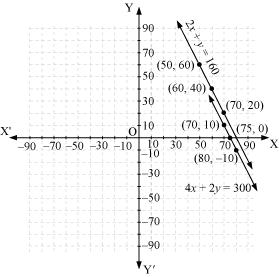
Concept insight: cost of apples and grapes needs to be found so the cost of 1 kg apples and 1 kg grapes will be taken as the variables. From the given conditions of collective cost of apples and grapes, a pair of linear equations in two variables will be obtained. Then, in order to represent the obtained equations graphically, take the values of variables as whole numbers only. Since these values are large so take the suitable scale like 1 cm = 20.
NCERT Solution for Class 10 Mathematics Chapter 3 - Pairs of Linear Equations in Two Variables Page/Excercise 3.2
Question 1
Form the pair of linear equations in the following problems, and find their solutions graphically.
(i) 10 students of Class X took part in a Mathematics quiz. If the number of girls is 4 more than the number of boys, find the number of boys and girls who took part in the quiz.
(ii) 5 pencils and 7 pens together cost Rs 50, whereas 7 pencils and 5 pens together cost Rs 46. Find the cost of one pencil and that of one pen.
(i) 10 students of Class X took part in a Mathematics quiz. If the number of girls is 4 more than the number of boys, find the number of boys and girls who took part in the quiz.
(ii) 5 pencils and 7 pens together cost Rs 50, whereas 7 pencils and 5 pens together cost Rs 46. Find the cost of one pencil and that of one pen.
Solution 1
(i) Let the number of girls and boys in the class be x and y respectively.
According to the given conditions, we have:
x + y = 10
x - y = 4
x + y = 10 x = 10 - y
x = 10 - y
Three solutions of this equation can be written in a table as follows:
According to the given conditions, we have:
x + y = 10
x - y = 4
x + y = 10
 x = 10 - y
x = 10 - y Three solutions of this equation can be written in a table as follows:
| x | 5 | 4 | 6 |
| y | 5 | 6 | 4 |
x - y = 4
 x = 4 + y
x = 4 + y Three solutions of this equation can be written in a table as follows:
| x | 5 | 4 | 3 |
| y | 1 | 0 | -1 |
The graphical representation is as follows:
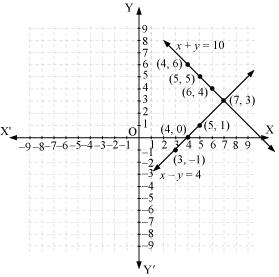
From the graph, it can be observed that the two lines intersect each other at the point (7, 3).
So, x = 7 and y = 3.
Thus, the number of girls and boys in the class are 7 and 3 respectively.
(ii) Let the cost of one pencil and one pen be Rs x and Rs y respectively.
According to the given conditions, we have:
5x + 7y = 50
7x + 5y = 46
Three solutions of this equation can be written in a table as follows:
| x | 3 | 10 | -4 |
| y | 5 | 0 | 10 |
Three solutions of this equation can be written in a table as follows:
| x | 8 | 3 | -2 |
| y | -2 | 5 | 12 |
The graphical representation is as follows:

From the graph, it can be observed that the two lines intersect each other at the point (3, 5).
So, x = 3 and y = 5.
Therefore, the cost of one pencil and one pen are Rs 3 and Rs 5 respectively.
Concept insight: Read the question carefully and examine what are the unknowns. Represent the given conditions with the help of equations by taking the unknowns quantities as variables. Also carefully state the variables as whole solution is based on it. On the graph paper, mark the points accurately and neatly using a sharp pencil. Also, take at least three points satisfying the two equations in order to obtain the correct straight line of the equation. Since joining any two points gives a straight line and if one of the points is computed incorrect will give a wrong line and taking third point will give a correct line. The point where the two straight lines will intersect will give the values of the two variables, i.e., the solution of the two linear equations. State the solution point.
Question 2
On comparing the ratios  , find out whether the lines representing the following pairs
, find out whether the lines representing the following pairs
of linear equations intersect at a point, are parallel or coincident:
Solution 2
(i) 5x - 4y + 8 = 0
7x + 6y - 9 = 0
Comparing these equations with a1x + b1y + c1 = 0 and a2x + b2y + c2 = 0, we get:
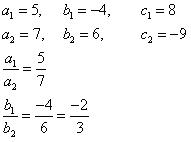
Since , the given pair of equations intersect at exactly one point.
, the given pair of equations intersect at exactly one point.
7x + 6y - 9 = 0
Comparing these equations with a1x + b1y + c1 = 0 and a2x + b2y + c2 = 0, we get:

Since
(ii) 9x + 3y + 12 = 0
18x + 6y + 24 = 0
Comparing these equations with a1x + b1y + c1 = 0 and a2x + b2y + c2 = 0, we get:
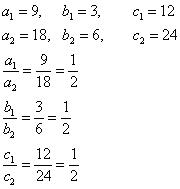
Since , the given pair of equation are coincident.
, the given pair of equation are coincident.
18x + 6y + 24 = 0
Comparing these equations with a1x + b1y + c1 = 0 and a2x + b2y + c2 = 0, we get:

Since
(iii) 6x - 3y + 10 = 0 , 2x - y + 9 = 0
Comparing these equations with a1x + b1y + c1 = 0 and a2x + b2y + c2 = 0, we get:
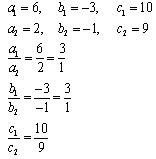
Since
Concept insight: In order to answer such questions, remember the condition for the pair of linear equations to be intersecting, parallel or coincident. Also, while writing the coefficients, don't forget to take the signs.
Question 3
On comparing the ratios,  , find out whether the following linear equations are consistent or inconsistent.
, find out whether the following linear equations are consistent or inconsistent.

 , find out whether the following linear equations are consistent or inconsistent.
, find out whether the following linear equations are consistent or inconsistent.
Solution 3

Since
Thus, the pair of linear equations is consistent.

Thus, the pair of linear equations is inconsistent.
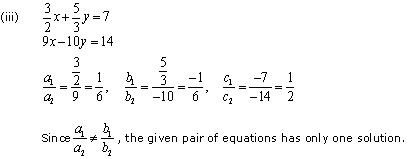
Thus, the pair of linear equations is consistent.

Thus, the pair of linear equations is consistent.

Thus, the pair of linear equations is consistent.
Concept Insight: If a pair of linear equations has one or more than one solution then they are said to be consistent and if they have no solution then they are said to be inconsistent. So, to identify the consistency of a given pair of equations, apply the conditions involving the coefficients of the given pair of equations.
In case, two consistent linear equations are plotted, they will either intersect or overlap each other.
Question 4
Which of the following pairs of linear equations are consistent/ inconsistent? If consistent, obtain the solution graphically:
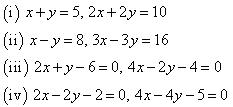

Solution 4

Thus, the pair of linear equations is consistent.
Now, x + y = 5
 x = 5 - y
x = 5 - yThree solutions of this equation can be written in a table as follows:
| x | 4 | 3 | 2 |
| y | 1 | 2 | 3 |
Three solutions of this equation can be written in a table as follows:
| x | 4 | 3 | 2 |
| y | 1 | 2 | 3 |
Thus, the graphical representation is as follows:
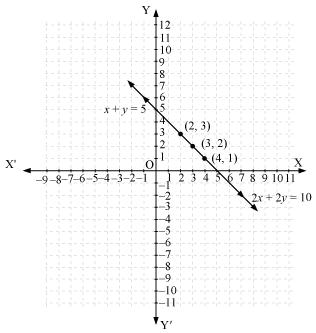
From the graph, it can be observed that the two lines coincide. Thus, the given pair of equations has infinite solutions.
Let x = k, then y = 5 - k. So, the ordered pair (k, 5 - k) , where k is a constant, will be the solution of the given pair of linear equations.

Thus, the pair of linear equations is inconsistent.

Thus, the pair of linear equations is consistent.
Now, 2x + y - 6 = 0
 y = 6 - 2x
y = 6 - 2xThree solutions of this equation can be written in a table as follows:
| x | 0 | 1 | 2 |
| y | 6 | 4 | 2 |
Three solutions of this equation can be written in a table as follows:
| x | 1 | 2 | 3 |
| y | 0 | 2 | 4 |
Thus, the graphical representation is as follows:

From the graph, it can be observed that the two lines intersect each other at the point (2, 2). Thus, the solution of the given pair of equations is (2, 2).

Thus, the pair of linear equations is inconsistent.
Concept insight: If a pair of linear equations has one or more than one solutions then they are said to be consistent and if they have no solution then they are said to be inconsistent. The graph of each equation can be plotted by taking at least three ordered pairs which are the solutions of the equations. The point where both the lines intersect will be the solution of the given pair of equations. Remember two overlapping lines intersect each other at infinitely many points. State the solution explicitly.
Question 5
Half the perimeter of a rectangular garden, whose length is 4 m more than its width, is 36 m. Find the dimensions of the garden.
Solution 5
Let the width and length of the rectangular garden be x and y respectively.
According to the given conditions,
y - x = 4
y + x = 36
y - x = 4 y = x + 4
y = x + 4
Three solutions of this equation can be written in a table as follows:
According to the given conditions,
y - x = 4
y + x = 36
y - x = 4
 y = x + 4
y = x + 4Three solutions of this equation can be written in a table as follows:
| x | 0 | 8 | 12 |
| y | 4 | 12 | 16 |
y + x = 36
Three solutions of this equation can be written in a table as follows:
| x | 0 | 36 | 16 |
| y | 36 | 0 | 20 |
Thus, the graphical representation is as follows:

From the graph, it can be observed that the two lines intersect each other at the point (16, 20). So, x = 16 and y = 20.
Thus, the length and width of the rectangular garden is 20 m and 16 m respectively.
Concept insight: Here dimensions of the rectangular garden needs to be found. Since opposite sides of the rectangle are equal so length and breadth can be taken as variables. Applying conditions given in the problem two linear equations in the 2 variables can be obtained. Now, in order to represent the obtained equations graphically, take the values of variables as whole numbers only, because then it will be easier to represent the values on the graph. The point where the two equations intersect will give the required dimensions. State the dimensions length and breadth from the values of the variables.
Question 6
Given the linear equation 2x + 3y - 8 = 0, write another linear equation in two variables such that the geometrical representation of the pair so formed is:
(i) Intersecting lines
(ii) Parallel lines
(iii) Coincident lines
(i) Intersecting lines
(ii) Parallel lines
(iii) Coincident lines
Solution 6
(i) For the two lines a1x + b1x + c1 = 0 and a2x + b2x + c2 = 0, to be intersecting, we must have

So, the other linear equation can be 5x + 6y - 16 = 0

(ii) For the two lines a1x + b1x + c1 = 0 and a2x + b2x + c2 = 0, to be parallel, we must have

So, the other linear equation can be 6x + 9y + 24 = 0,

(iii) For the two lines a1x + b1x + c1 = 0 and a2x + b2x + c2 = 0 to be coincident, we must have

So, the other linear equation can be 8x + 12y - 32 = 0,

Concept insight: In order to answer such type of problems, just remember the conditions for two lines to be intersecting, parallel, and coincident. This problem will have multiple answers as their can be many equations satisfying the required conditions.

So, the other linear equation can be 5x + 6y - 16 = 0
(ii) For the two lines a1x + b1x + c1 = 0 and a2x + b2x + c2 = 0, to be parallel, we must have

So, the other linear equation can be 6x + 9y + 24 = 0,

(iii) For the two lines a1x + b1x + c1 = 0 and a2x + b2x + c2 = 0 to be coincident, we must have

So, the other linear equation can be 8x + 12y - 32 = 0,

Concept insight: In order to answer such type of problems, just remember the conditions for two lines to be intersecting, parallel, and coincident. This problem will have multiple answers as their can be many equations satisfying the required conditions.
Question 7
Draw the graphs of the equations x - y + 1 = 0 and 3x + 2y - 12 = 0. Determine the coordinates of the vertices of the triangle formed by these lines and the x-axis, and shade the triangular region.
Solution 7
x - y + 1 = 0  x = y - 1
x = y - 1
Three solutions of this equation can be written in a table as follows:
 x = y - 1
x = y - 1 Three solutions of this equation can be written in a table as follows:
| x | 0 | 1 | 2 |
| y | 1 | 2 | 3 |
Three solutions of this equation can be written in a table as follows:
| x | 4 | 2 | 0 |
| y | 0 | 3 | 6 |
Now, these equations can be drawn on a graph. The triangle formed by the two lines and the x-axis can be shown by the shaded part as:
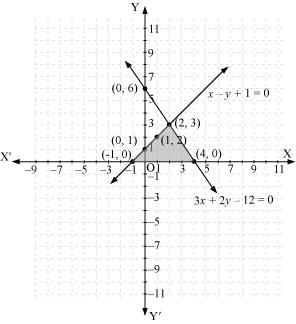
From the graph, it can be observed that the coordinates of the vertices of the triangle so formed are (2, 3), (-1, 0), and (4, 0).
Concept insight: In order to find the coordinates of the vertices of the triangle so formed, find the points where the two lines intersects the x-axis and also where the two lines intersect each other. Note here that the coordinates of the intersection of lines with x-axis is taken and not with y-axis, this is because the question says to find the triangle formed by the two lines and the x-axis.
NCERT Solution for Class 10 Mathematics Chapter 3 - Pairs of Linear Equations in Two Variables Page/Excercise 3.3
Question 1
Solve the following pair of linear equations by the substitution method.
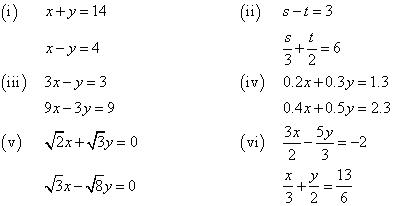

Solution 1
(i) x + y = 14 ... (i)
x - y = 4 ... (ii)
From (i), we obtain:
x = 14 - y ... (iii)
Substituting this value in equation (ii), we obtain:

Substituting the value of y in equation (iii), we obtain:


From (i), we obtain:
s = t + 3 ...(iii)
Substituting this value in equation (ii), we obtain:
Substituting the value of t in equation (iii), we obtain:
s = 9

(iii) 3x - y = 3 ... (i)
9x - 3y = 9 ... (ii)
From (i), we obtain
y = 3x - 3 ... (iii)
Substituting this value in equation (ii), we obtain:

9 = 9
This is always true.
Thus, the given pair of equations has infinitely many solutions and the relation between these variables can be given by
y = 3x - 3
So, one of the possible solutions can x = 3, y = 6.
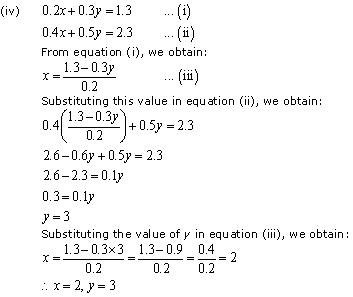
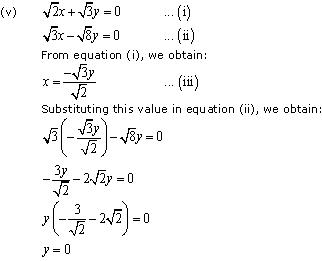
Substituting the value of y in equation (iii), we obtain:
x = 0

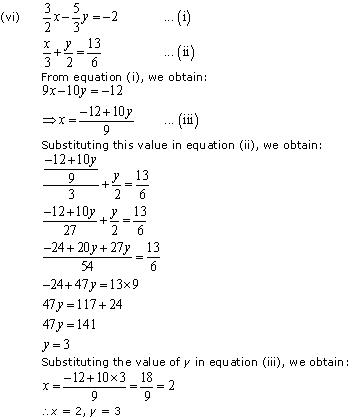
Concept insight: In order to solve the given pairs of equations, we need to substitute the value of any one of the variable from any one of the equation. But make sure to substitute the value of that variable which simplifies calculations. For example, in part (iv) it is most convenient to substitute the value of x from the first equation to the second equation, as the division by 0.2 is more easier than the division by 0.3, 0.4 and 0.5.
x - y = 4 ... (ii)
From (i), we obtain:
x = 14 - y ... (iii)
Substituting this value in equation (ii), we obtain:

Substituting the value of y in equation (iii), we obtain:

From (i), we obtain:
s = t + 3 ...(iii)
Substituting this value in equation (ii), we obtain:

Substituting the value of t in equation (iii), we obtain:
s = 9
(iii) 3x - y = 3 ... (i)
9x - 3y = 9 ... (ii)
From (i), we obtain
y = 3x - 3 ... (iii)
Substituting this value in equation (ii), we obtain:
9 = 9
This is always true.
Thus, the given pair of equations has infinitely many solutions and the relation between these variables can be given by
y = 3x - 3
So, one of the possible solutions can x = 3, y = 6.


Substituting the value of y in equation (iii), we obtain:
x = 0

Concept insight: In order to solve the given pairs of equations, we need to substitute the value of any one of the variable from any one of the equation. But make sure to substitute the value of that variable which simplifies calculations. For example, in part (iv) it is most convenient to substitute the value of x from the first equation to the second equation, as the division by 0.2 is more easier than the division by 0.3, 0.4 and 0.5.
Question 2
Solve 2x + 3y = 11 and 2x - 4y = -24 and hence find the value of 'm' for which y = mx + 3.
Solution 2
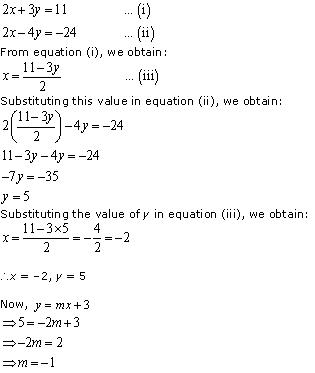
Thus, the value of m is -1.
Concept insight: Firstly the solution of the given pair of linear equations can be found out by substituting the value of one variable, say x, from one equation into the other equation. Then after finding out the values of x and y, substitute them in the equation y = m x + 3 in order to find the value of m.
Question 3
Form the pair of linear equations for the following problems and find their solution by substitution method.
(i) The difference between two numbers is 26 and one number is three times the other. Find them.
(ii) The larger of two supplementary angles exceeds the smaller by 18 degrees. Find them.
(iii) The coach of a cricket team buys 7 bats and 6 balls for Rs 3800. Later, she buys 3 bats and 5 balls for Rs 1750. Find the cost of each bat and each ball.
(iv) The taxi charges in a city consist of a fixed charge together with the charge for the distance covered. For a distance of 10 km, the charge paid is Rs 105 and for a journey of 15 km, the charge paid is Rs 155. What are the fixed charges and the charge per km? How much does a person have to pay for travelling a distance of 25 km.
(v) A fraction becomes  , if 2 is added to both, the numberator and the denominator. If 3 is added to both, the numerator and the denominator, it becomes
, if 2 is added to both, the numberator and the denominator. If 3 is added to both, the numerator and the denominator, it becomes  . Find the fraction.
. Find the fraction.
(vi) Five years hence, the age of Jacob will be three times that of his son. Five years ago, Jacob's age was seven times that of his son. What are their present ages?
(i) The difference between two numbers is 26 and one number is three times the other. Find them.
(ii) The larger of two supplementary angles exceeds the smaller by 18 degrees. Find them.
(iii) The coach of a cricket team buys 7 bats and 6 balls for Rs 3800. Later, she buys 3 bats and 5 balls for Rs 1750. Find the cost of each bat and each ball.
(iv) The taxi charges in a city consist of a fixed charge together with the charge for the distance covered. For a distance of 10 km, the charge paid is Rs 105 and for a journey of 15 km, the charge paid is Rs 155. What are the fixed charges and the charge per km? How much does a person have to pay for travelling a distance of 25 km.
 , if 2 is added to both, the numberator and the denominator. If 3 is added to both, the numerator and the denominator, it becomes
, if 2 is added to both, the numberator and the denominator. If 3 is added to both, the numerator and the denominator, it becomes  . Find the fraction.
. Find the fraction.(vi) Five years hence, the age of Jacob will be three times that of his son. Five years ago, Jacob's age was seven times that of his son. What are their present ages?
Solution 3
(i) Let one number be x and the other number be y such that y > x.
According to the question:

Substituting this in equation (1), we obtain
y = 39
Hence, the numbers are 13 and 39.
Concept insight: In this problem, two relations between two numbers are given. So, the two numbers have to be found out here. So the two numbers will be represented by variables x and y explicitly state the greater variable.
A pair of equations can be obtained from the given conditions. The pair of equations can then be solved by suitable substitution.
(ii) Let the larger angle be x and smaller angle be y.
We know that the sum of the measures of angles of a supplementary pair is always 180º.
According to the given information,

From (1), we obtain
x = 180º - y (3)
Substituting this in equation (2), we obtain

Putting this in equation (3), we obtain
x = 180º - 81º
= 99º
Hence, the angles are 99º and 81º.
Concept insight: This problem talks about the measure of two supplementary angles. So, the two angles will be written as variables. The pair of equations can be formed using the fact that the sum of two supplementary angles is 180° and using the condition given in the problem. The pair of equations can then be solved by suitable substitution.
(iii) Let the cost of a bat and a ball be x and y respectively.
According to the given information,
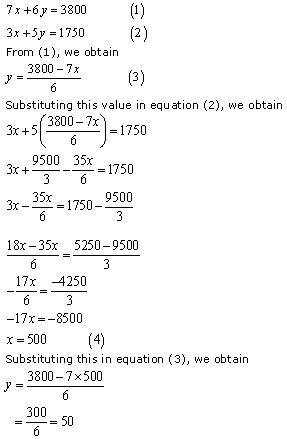
Hence, the cost of a bat is Rs 500 and that of a ball is Rs 50.
Concept insight: Cost of bats and balls needs to be found so the cost of a ball and bat will be taken as the variables. Applying the conditions of total cost of bats and balls algebraic equations will be obtained. The pair of equations can then be solved by suitable substitution.
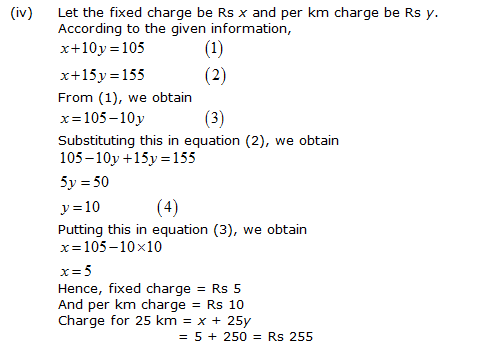
Concept insight: In this problem, we are required to find out the fixed charge and the charge per km. So, we will represent these two by using different variables. Now, two linear equations can be written by using the conditions given in the problem. The pair of equations can then be solved by suitable substitution.
(v) Let the fraction be
According to the given information,

Concept insight: This problem talks about a fraction which is not known to us. So numerator and denominators will be taken to be variables x and y respectively and y will be strictly non zero. Then, a pair of linear equations can be formed from the given conditions. The pair of equations can then be solved by suitable substitution.
(vi) Let the age of Jacob be x and the age of his son be y.
According to the given information,
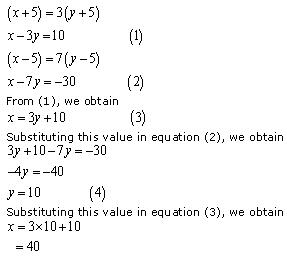
Hence, the present age of Jacob is 40 years whereas the present age of his son is 10 years.
Concept insight: Here, Jacob's and his son's present age are not known. So, we will write both these in terms of variables. The problem talks about their ages five years ago and five years hence. Here, five years ago means we have to subtract 5 from their present ages, and five years hence means we have to add 3 to their present ages. So, using the given conditions, a pair of linear equations can be formed. The pair of equations can then be solved by suitable substitution.
According to the question:

Substituting this in equation (1), we obtain
y = 39
Hence, the numbers are 13 and 39.
Concept insight: In this problem, two relations between two numbers are given. So, the two numbers have to be found out here. So the two numbers will be represented by variables x and y explicitly state the greater variable.
A pair of equations can be obtained from the given conditions. The pair of equations can then be solved by suitable substitution.
(ii) Let the larger angle be x and smaller angle be y.
We know that the sum of the measures of angles of a supplementary pair is always 180º.
According to the given information,
From (1), we obtain
x = 180º - y (3)
Substituting this in equation (2), we obtain

Putting this in equation (3), we obtain
x = 180º - 81º
= 99º
Hence, the angles are 99º and 81º.
Concept insight: This problem talks about the measure of two supplementary angles. So, the two angles will be written as variables. The pair of equations can be formed using the fact that the sum of two supplementary angles is 180° and using the condition given in the problem. The pair of equations can then be solved by suitable substitution.
(iii) Let the cost of a bat and a ball be x and y respectively.
According to the given information,

Hence, the cost of a bat is Rs 500 and that of a ball is Rs 50.
Concept insight: Cost of bats and balls needs to be found so the cost of a ball and bat will be taken as the variables. Applying the conditions of total cost of bats and balls algebraic equations will be obtained. The pair of equations can then be solved by suitable substitution.

Concept insight: In this problem, we are required to find out the fixed charge and the charge per km. So, we will represent these two by using different variables. Now, two linear equations can be written by using the conditions given in the problem. The pair of equations can then be solved by suitable substitution.
(v) Let the fraction be

According to the given information,

Concept insight: This problem talks about a fraction which is not known to us. So numerator and denominators will be taken to be variables x and y respectively and y will be strictly non zero. Then, a pair of linear equations can be formed from the given conditions. The pair of equations can then be solved by suitable substitution.
(vi) Let the age of Jacob be x and the age of his son be y.
According to the given information,

Hence, the present age of Jacob is 40 years whereas the present age of his son is 10 years.
Concept insight: Here, Jacob's and his son's present age are not known. So, we will write both these in terms of variables. The problem talks about their ages five years ago and five years hence. Here, five years ago means we have to subtract 5 from their present ages, and five years hence means we have to add 3 to their present ages. So, using the given conditions, a pair of linear equations can be formed. The pair of equations can then be solved by suitable substitution.
NCERT Solution for Class 10 Mathematics Chapter 3 - Pairs of Linear Equations in Two Variables Page/Excercise 3.4
Question 1
Solve the following pair of linear equations by the elimination method and the substitution method:


Solution 1
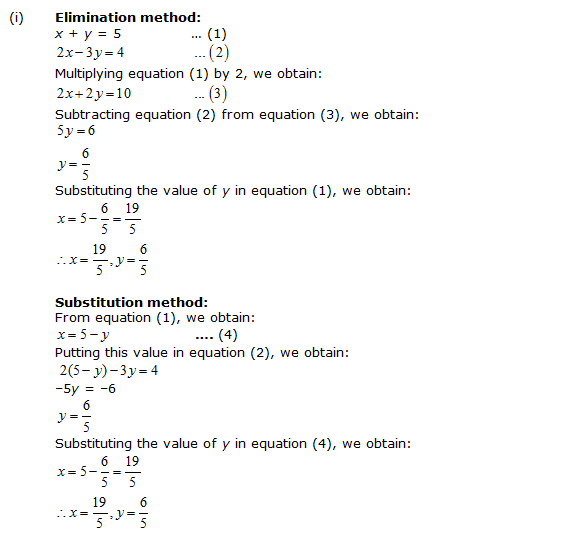
(ii) Elimination method:
3x + 4y = 10 ...(1)
2x - 2y = 2 ...(2)
Multiplying equation (2) by 2, we obtain:
4x - 4y = 4 ...(3)
Adding equation (1) and (3), we obtain
7x = 14
x = 2
Substituting the value of x in equation (1), we obtain:
6 + 4y = 10
4y = 4
y = 1
Hence, x = 2, y = 1
Substitution method:
From equation (2), we obtain:
x = 1 + y ...(4)
Putting this value in equation (1), we obtain:
3(1 + y) + 4y = 10.
7y = 7
y = 1
Substituting the value of y in equation (4), we obtain:
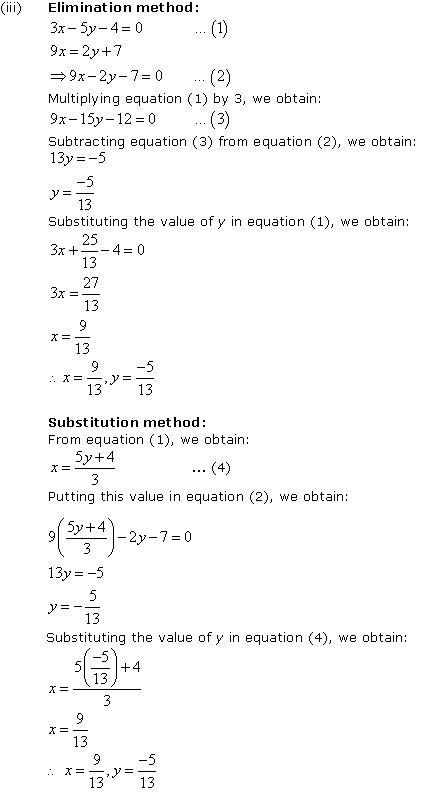
Substitution method:
From equation (1), we obtain:
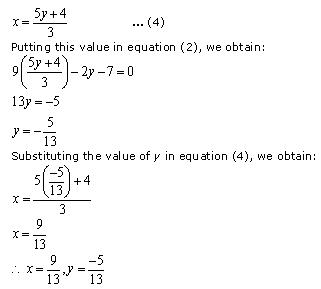
Substitution method:
From equation (2), we obtain:
y = 3x - 9 ... (3)
Putting this value in equation (1), we obtain:
3x + 4(3x - 9) = -6
15x = 30
x = 2
Substituting the value of x in equation (3), we obtain:
y = 6 - 9 = -3
Concept insight: In order to solve the given pairs of equations by elimination method, it is required to eliminate one variable to get a linear equation in one variable. For elimination, we multiply one equation (or sometimes even both equations) by suitable constant to make the coefficient of one variable same in both the equations. The trick is to eliminate that variable which involves lesser computations.
In order to solve the given pair of equations by substitution method, we need to substitute the value of any one of the variable from any one of the equation. The trick here is to make sure you substitute the value of that variable which simplifies your calculations.
Note that the solution must be same in both the cases.
Question 2
Form the pair of linear equations in the following problems, and find their solutions (if they exist) by the elimination method:
(i) If we add 1 to the numerator and subtract 1 from the denominator, a fraction reduces to 1. It becomes  if we only add 1 to the denominator. What is the fraction?
if we only add 1 to the denominator. What is the fraction?
(ii) Five years ago, Nuri was thrice as old as Sonu. Ten years later, Nuri will be twice as old as Sonu. How old are Nuri and Sonu?
(iii) The sum of the digits of a two-digit number is 9. Also, nine times this number is twice the number obtained by reversing the order of the digits. Find the number.
(iv) Meena went to bank to withdraw Rs 2000. She asked the cashier to give her Rs 50 and Rs 100 notes only. Meena got 25 notes in all. Find how many notes of Rs 50 and Rs 100 she received.
(v) A lending library has a fixed charge for the first three days and an additional charge for each day thereafter. Saritha paid Rs 27 for a book kept for seven days, while Susy paid Rs 21 for the book she kept for five days. Find the fixed charge and the charge for each extra day.
(i) If we add 1 to the numerator and subtract 1 from the denominator, a fraction reduces to 1. It becomes
 if we only add 1 to the denominator. What is the fraction?
if we only add 1 to the denominator. What is the fraction? (ii) Five years ago, Nuri was thrice as old as Sonu. Ten years later, Nuri will be twice as old as Sonu. How old are Nuri and Sonu?
(iii) The sum of the digits of a two-digit number is 9. Also, nine times this number is twice the number obtained by reversing the order of the digits. Find the number.
(iv) Meena went to bank to withdraw Rs 2000. She asked the cashier to give her Rs 50 and Rs 100 notes only. Meena got 25 notes in all. Find how many notes of Rs 50 and Rs 100 she received.
(v) A lending library has a fixed charge for the first three days and an additional charge for each day thereafter. Saritha paid Rs 27 for a book kept for seven days, while Susy paid Rs 21 for the book she kept for five days. Find the fixed charge and the charge for each extra day.
Solution 2
(i) Let the fraction be 
According to the question,
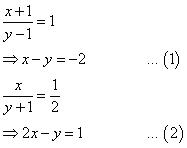
Subtracting equation (1) from equation (2), we obtain:
x = 3
Substituting this value of x in equation (1), we obtain:

Concept insight: This problem talks about a fraction. The numerator and denominator of the fraction are not known so we represent these as variables x and y respectively where variable y must be non zero. Then, a pair of linear equations can be formed from the given conditions. The pair of equations can then be solved by eliminating a suitable variable.
(ii) Let present age of Nuri and Sonu be x and y respectively.
According to the question,
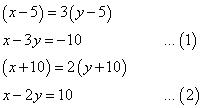
Subtracting equation (1) from equation (2), we obtain:
y = 20
Substituting the value of y in equation (1), we obtain:

Thus, the age of Nuri and Sonu are 50 years and 20 years respectively.
Concept insight: Here, Nuri's and Sonu's present age are not known. So, we will write both these in terms of variables. Then, using the given conditions, a pair of linear equations can be formed. The pair of equations can then be solved by eliminating a suitable variable.
(iii) Let the units digit and tens digit of the number be x and y respectively.
Number = 10y + x
Number after reversing the digits = 10x + y
According to the question,
x + y = 9 ... (1)
9(10y + x) = 2(10x + y)
88y - 11x = 0
- x + 8y =0 ... (2)
Adding equations (1) and (2), we obtain:
9y = 9
y = 1
Substituting the value of y in equation (1), we obtain:
x = 8
Thus, the number is 10y + x = 10 x 1 + 8 = 18
Concept insight: This problem talks about a two digit number. Here, remember that a two digit number xy can be expanded as 10x + y. Then, using the two given conditions, a pair of linear equations can be formed which can be solved by eliminating one of the variables.
(iv) Let the number of Rs 50 notes and Rs 100 notes be x and y respectively.
According to the question,

Multiplying equation (1) by 50, we obtain:
50x + 50 y = 1250
Subtracting equation (3) from equation (2), we obtain:
50y = 750
y = 15
Substituting the value of y in equation (1), we obtain:
x = 10
Hence, Meena received 10 notes of Rs 50 and 15 notes of Rs 100.
Concept insight: This problem talks about two types of notes, Rs 50 notes and Rs 100 notes. And the number of both these notes with Meena is not known. So, we denote the number of Rs 50 notes and Rs 100 notes by variables x and y respectively. Now two linear equations can be formed by the given conditions which can be solved by eliminating one of the variables.
(v) Let the fixed charge for first three days and each day charge thereafter be Rs x and Rs y respectively.
According to the question,

Subtracting equation (2) from equation (1), we obtain:
2y = 6
y = 3
Substituting the value of y in equation (1), we obtain:
x + 12 = 27
x = 15
Hence, the fixed charge is Rs 15 and the charge per day is Rs 3.
Concept insight: Here, the fixed charges for the first three days and per day charges are not known so, they will be represented using two different variables. The two equations can then be obtained by using the given conditions which can be solved by eliminating one of the variables.
According to the question,

Subtracting equation (1) from equation (2), we obtain:
x = 3
Substituting this value of x in equation (1), we obtain:

Concept insight: This problem talks about a fraction. The numerator and denominator of the fraction are not known so we represent these as variables x and y respectively where variable y must be non zero. Then, a pair of linear equations can be formed from the given conditions. The pair of equations can then be solved by eliminating a suitable variable.
(ii) Let present age of Nuri and Sonu be x and y respectively.
According to the question,

Subtracting equation (1) from equation (2), we obtain:
y = 20
Substituting the value of y in equation (1), we obtain:
Thus, the age of Nuri and Sonu are 50 years and 20 years respectively.
Concept insight: Here, Nuri's and Sonu's present age are not known. So, we will write both these in terms of variables. Then, using the given conditions, a pair of linear equations can be formed. The pair of equations can then be solved by eliminating a suitable variable.
(iii) Let the units digit and tens digit of the number be x and y respectively.
Number = 10y + x
Number after reversing the digits = 10x + y
According to the question,
x + y = 9 ... (1)
9(10y + x) = 2(10x + y)
88y - 11x = 0
- x + 8y =0 ... (2)
Adding equations (1) and (2), we obtain:
9y = 9
y = 1
Substituting the value of y in equation (1), we obtain:
x = 8
Thus, the number is 10y + x = 10 x 1 + 8 = 18
Concept insight: This problem talks about a two digit number. Here, remember that a two digit number xy can be expanded as 10x + y. Then, using the two given conditions, a pair of linear equations can be formed which can be solved by eliminating one of the variables.
(iv) Let the number of Rs 50 notes and Rs 100 notes be x and y respectively.
According to the question,

Multiplying equation (1) by 50, we obtain:
50x + 50 y = 1250
Subtracting equation (3) from equation (2), we obtain:
50y = 750
y = 15
Substituting the value of y in equation (1), we obtain:
x = 10
Hence, Meena received 10 notes of Rs 50 and 15 notes of Rs 100.
Concept insight: This problem talks about two types of notes, Rs 50 notes and Rs 100 notes. And the number of both these notes with Meena is not known. So, we denote the number of Rs 50 notes and Rs 100 notes by variables x and y respectively. Now two linear equations can be formed by the given conditions which can be solved by eliminating one of the variables.
(v) Let the fixed charge for first three days and each day charge thereafter be Rs x and Rs y respectively.
According to the question,

Subtracting equation (2) from equation (1), we obtain:
2y = 6
y = 3
Substituting the value of y in equation (1), we obtain:
x + 12 = 27
x = 15
Hence, the fixed charge is Rs 15 and the charge per day is Rs 3.
Concept insight: Here, the fixed charges for the first three days and per day charges are not known so, they will be represented using two different variables. The two equations can then be obtained by using the given conditions which can be solved by eliminating one of the variables.
NCERT Solution for Class 10 Mathematics Chapter 3 - Pairs of Linear Equations in Two Variables Page/Excercise 3.5
Question 1
Which of the following pairs of linear equations has unique solution, no solution or infinitely many solutions? In case there is a unique solution, find it by using cross multiplication method.


Solution 1

Thus, the given pair of equations has no solution.
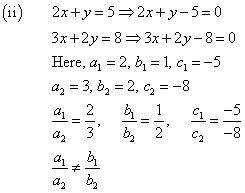
Thus, the given pair of equations has unique solution.
By cross-multiplication method,
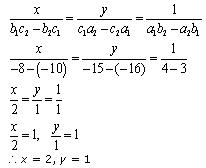
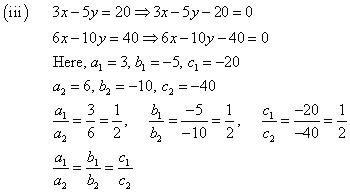
Thus, the given pair of equations has infinite solutions.
The solutions can be obtained by assuming the value of x to be k, where k is any
constant. So, the ordered pairs  , where k is a constant, are the solutions of
, where k is a constant, are the solutions of
the given pair of equations.
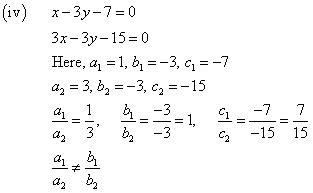
Thus, the given pair of equations has unique solution.
By cross-multiplication,
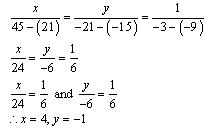
Concept Insight: In order to answer such questions, remember the condition for the pair of linear equations to have unique, infinitely many or no solution relating the coefficients. Also, remember the formula used to solve by cross multiplication method. While applying the formula, be careful about the signs of the coefficients. And above all don't forget to first write the linear equations in standard form which is ax + by + c = 0.

Thus, the given pair of equations has unique solution.
By cross-multiplication,

Concept Insight: In order to answer such questions, remember the condition for the pair of linear equations to have unique, infinitely many or no solution relating the coefficients. Also, remember the formula used to solve by cross multiplication method. While applying the formula, be careful about the signs of the coefficients. And above all don't forget to first write the linear equations in standard form which is ax + by + c = 0.
Question 2
(i) For which values of a and b will the following pair of linear equations have an infinite number of solutions?

(ii) For which value of k will the following pair of linear equations have no solution?

(ii) For which value of k will the following pair of linear equations have no solution?
Solution 2
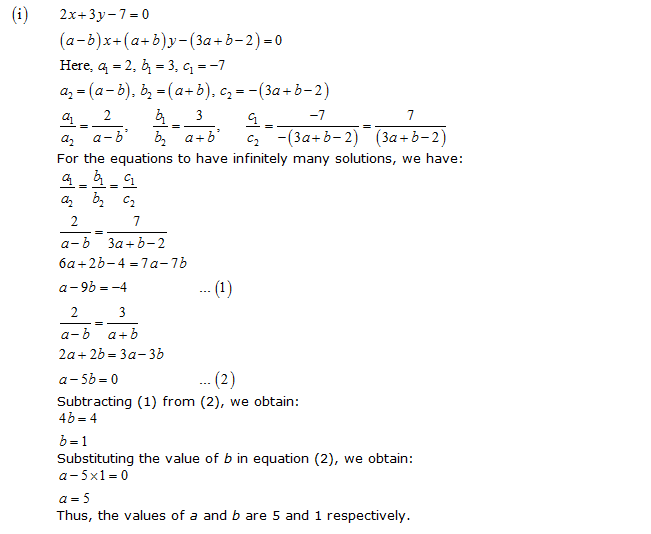
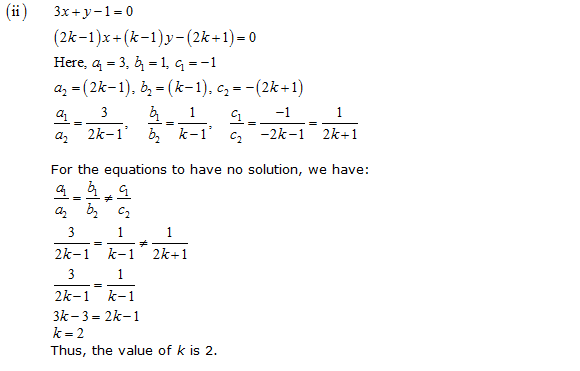
Concept insight: In order to solve such problems, firstly write the linear equations in standard form which is ax + by + c = 0.To find the value of the unknowns, the key idea is to remember the conditions for a given pair of equations to have infinite solutions and no solution. In case of infinite solutions rule out the values which does not satisfy all the ratios. Also, be careful about the signs of the coefficients.
Question 3
Solve the following pair of linear equations by the substitution and cross-multiplication methods:

Solution 3
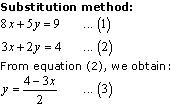
Substituting this value of y in equation (1), we obtain:

Cross-multiplication method:
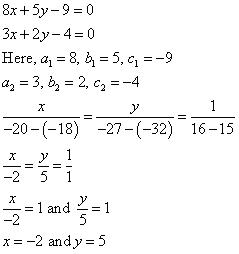
Concept insight: In order to solve the given pair of equations by cross multiplication method, remember the formula to be used and convert the system of equations to standard form. While applying the formula, be careful about the signs of the coefficients.
In order to solve the given pair of equations by substitution method, substitute the value of any one of the variable from any one of the equation. Make sure you substitute the value of that variable which simplifies your calculations.
Solution will be same in both cases
Question 4
Form the pair of linear equations in the following problems and find their solutions (if they exist) by any algebraic method:
(i) A part of monthly hostel charges is fixed and the remaining depends on the number of days one has taken food in the mess. When a student A takes food for 20 days she has to pay Rs 1000 as hostel charges whereas a student B, who takes food for 26 days, pays Rs 1180 as hostel charges. Find the fixed charges and the cost of food per day. (ii) A fraction becomes  when 1 is subtracted from the numerator and it becomes
when 1 is subtracted from the numerator and it becomes  when 8 is added to its denominator. Find the fraction. (iii) Yash scored 40 marks in a test, getting 3 marks for each right answer and losing 1 mark for each wrong answer. Had 4 marks been awarded for each correct answer and 2 marks been deducted for each incorrect answer, then Yash would have scored 50 marks. How many questions were there in the test? (iv) Places A and B are 100 km apart on a highway. One car starts from A and another from B at the same time. If the cars travel in the same direction at different speeds, they meet in 5 hours. If they travel towards each other, they meet in 1 hour. What are the speeds of the two cars?
when 8 is added to its denominator. Find the fraction. (iii) Yash scored 40 marks in a test, getting 3 marks for each right answer and losing 1 mark for each wrong answer. Had 4 marks been awarded for each correct answer and 2 marks been deducted for each incorrect answer, then Yash would have scored 50 marks. How many questions were there in the test? (iv) Places A and B are 100 km apart on a highway. One car starts from A and another from B at the same time. If the cars travel in the same direction at different speeds, they meet in 5 hours. If they travel towards each other, they meet in 1 hour. What are the speeds of the two cars?
(v) The area of a rectangle gets reduced by 9 square units, if its length is reduced by 5 units and breadth is increased by 3 units. If we increase the length by 3 units and the breadth by 2 units, the area increases by 67 square units. Find the dimensions of the rectangle.
(i) A part of monthly hostel charges is fixed and the remaining depends on the number of days one has taken food in the mess. When a student A takes food for 20 days she has to pay Rs 1000 as hostel charges whereas a student B, who takes food for 26 days, pays Rs 1180 as hostel charges. Find the fixed charges and the cost of food per day. (ii) A fraction becomes
(v) The area of a rectangle gets reduced by 9 square units, if its length is reduced by 5 units and breadth is increased by 3 units. If we increase the length by 3 units and the breadth by 2 units, the area increases by 67 square units. Find the dimensions of the rectangle.
Solution 4
(i) Let the fixed charge of the food and the charge for food per day be x and y respectively.
According to the question,
x + 20y = 1000 ...(1)
x + 26y = 1180 ...(2)
Substituting this value of y in equation (1) from equation (2), we obtain
6y = 180
y = 30
Substituting this value of y in equation (1), we obtain:
x+ 20 x 30 = 1000
x = 1000 - 600
x = 400
Thus, the fixed charge of the food and the charge per day are Rs 400 and Rs 30 respectively.
Concept insight: Here, the fixed charge of the food and charge for food per day are the unknown quantities. So they are taken as variables x and y. The two equations can then be obtained by using the given conditions. You will observe that the variable x has the same coefficient in both the equations, so it will be easier to find the solution by eliminating x from both the equations. Also, one can solve the system by other methods.
(ii) Let the fraction be According to the question,
According to the question,
According to the question,
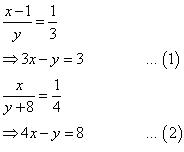
Subtracting equation (1) from equation (2), we obtain:
x = 5
Putting the value of x in equation (1), we obtain:
15 - y = 3
y = 12

Concept insight: Since the problem asks for a fraction. The numerator and denominator of the fraction need to be represented by variables. A pair of linear equations can be obtained from the given conditions. Observe that the variable y has the same coefficient in both the equations, so it will be easier to find the solution by eliminating y from both the equations.
(iii) Let the number of right answers and wrong answers be x and y
respectively.
According to the question,

Subtracting equation (2) from equation (1), we obtain:
x = 15
Substituting the value of x in equation (2), we obtain:
30 - y = 25
y = 5
Thus, the number of right answers and the number of wrong answers is 15 and 5 respectively.
Therefore, the total number of questions is 20.
Concept insight: In this problem, the number of write answers and the number of wrong answers answered by Yash are the unknown quantities. So, they must be represented by two variables. A pair of linear equations can be obtained by applying the given condition. Variable y has the same coefficient in both the equations, so it will be easier to find the solution by eliminating y from both the equations.
(iv) Let the speed of first car and second car be u km/h and v km/h respectively.
Speed of both cars while they are travelling in same direction = (u - v) km/h
Speed of both cars while they are travelling in opposite directions i.e., when they are travelling towards each other = (u + v) km/h
Distance travelled = Speed x Time
According to the question,
x + 20y = 1000 ...(1)
x + 26y = 1180 ...(2)
Substituting this value of y in equation (1) from equation (2), we obtain
6y = 180
y = 30
Substituting this value of y in equation (1), we obtain:
x+ 20 x 30 = 1000
x = 1000 - 600
x = 400
Thus, the fixed charge of the food and the charge per day are Rs 400 and Rs 30 respectively.
Concept insight: Here, the fixed charge of the food and charge for food per day are the unknown quantities. So they are taken as variables x and y. The two equations can then be obtained by using the given conditions. You will observe that the variable x has the same coefficient in both the equations, so it will be easier to find the solution by eliminating x from both the equations. Also, one can solve the system by other methods.
(ii) Let the fraction be
According to the question,

Subtracting equation (1) from equation (2), we obtain:
x = 5
Putting the value of x in equation (1), we obtain:
15 - y = 3
y = 12
Concept insight: Since the problem asks for a fraction. The numerator and denominator of the fraction need to be represented by variables. A pair of linear equations can be obtained from the given conditions. Observe that the variable y has the same coefficient in both the equations, so it will be easier to find the solution by eliminating y from both the equations.
(iii) Let the number of right answers and wrong answers be x and y
respectively.
According to the question,

Subtracting equation (2) from equation (1), we obtain:
x = 15
Substituting the value of x in equation (2), we obtain:
30 - y = 25
y = 5
Thus, the number of right answers and the number of wrong answers is 15 and 5 respectively.
Therefore, the total number of questions is 20.
Concept insight: In this problem, the number of write answers and the number of wrong answers answered by Yash are the unknown quantities. So, they must be represented by two variables. A pair of linear equations can be obtained by applying the given condition. Variable y has the same coefficient in both the equations, so it will be easier to find the solution by eliminating y from both the equations.
(iv) Let the speed of first car and second car be u km/h and v km/h respectively.
Speed of both cars while they are travelling in same direction = (u - v) km/h
Speed of both cars while they are travelling in opposite directions i.e., when they are travelling towards each other = (u + v) km/h
Distance travelled = Speed x Time
According to the question,
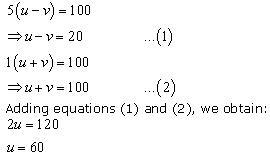
Substituting the value of u in equation (2), we obtain:
v = 40
Hence, speed of the first car is 60 km/h and speed of the second car is 40 km/h.
Concept insight: In this problem, the speeds of the two cars are not known so we will represent them by variables. Remember that when the cars are travel in the same direction, then the speed will be equal to the difference of their speeds and when they travel in opposite direction, then the speed will be equal to the sum of their speeds. Don't miss to write the unit.
(v) Let length and breadth of rectangle be x unit and y unit respectively.
Area = xy
According to the question,
Area = xy
According to the question,
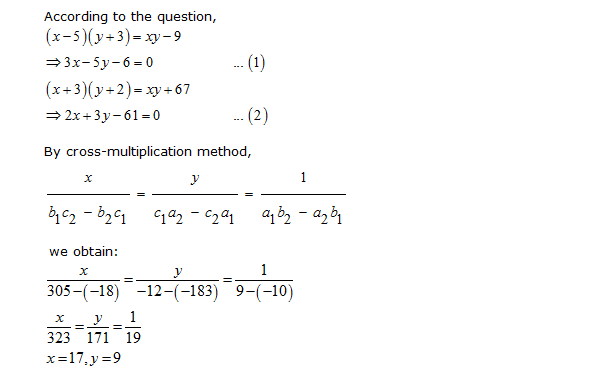
Thus, the length and breadth of the rectangle are 17 units and 9 units respectively.
Concept insight: Here, the length and the breadth of the rectangle will be represented by variables. Then, the pair of equations will be written from the given conditions. Solution can be easily computed using the cross multiplication method.
NCERT Solution for Class 10 Mathematics Chapter 3 - Pairs of Linear Equations in Two Variables Page/Excercise 3.6
Question 1
Solve the following pairs of equations by reducing them to a pair of linear equations:
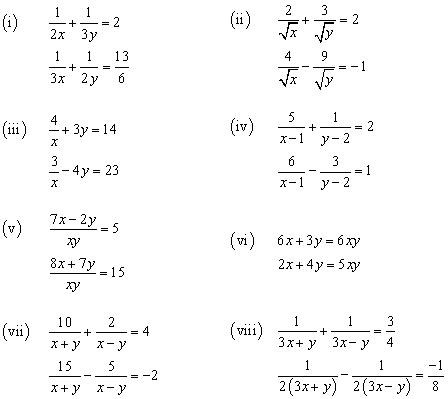

Solution 1
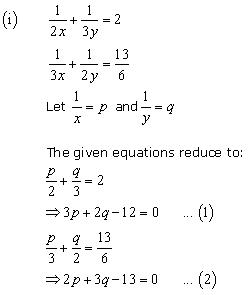
Using cross-multiplication method, we obtain:
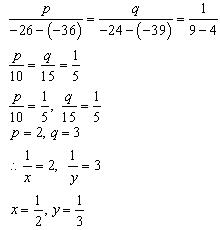
Concept insight: Here, the two given equations are not linear as the variables x and y both are in the denominator. By substituting
linear equation in variables p and q. Note here that we are assuming the variables x and y to be non-zero, because only then the given equations will make sense. The linear equations can be solved by using any suitable algebraic method. Also, do not forget here that we need to find the values of x and y. So, put the values of p and q to find x and y.
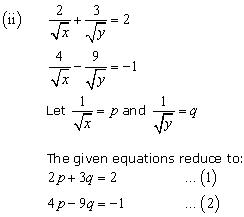
Multiplying equation (1) by 3, we obtain:
6p + 9q = 6 (3)
Adding equation (2) and (3), we obtain:

Concept insight: Here, the two given equations are not linear as it involves x-1/2 and y-1/2 If we substitute
linear form in variables p and q. Note here that we are assuming the variables x and y to be non negative real numbers. The linear equations can be solved by using any suitable algebraic method. Also, do not forget here that we need to find the values of x and y. So, put the values of p and q to find x and y.
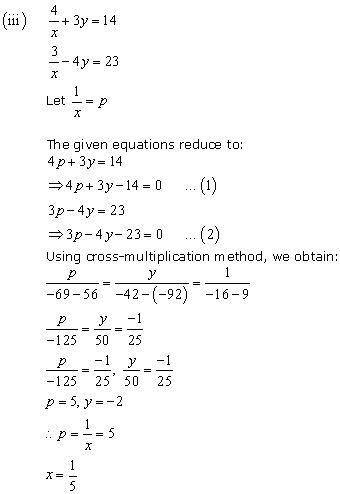
Concept insight: Here, the two given equations are not linear as the variable x is in the denominator. If we substitute
variables p and y. Note here that we are assuming the variable x to be non-zero. The linear equations can be solved by using any suitable algebraic method. Also, do not forget here that we need to find the values of x and y. So, put the value of p to find x.
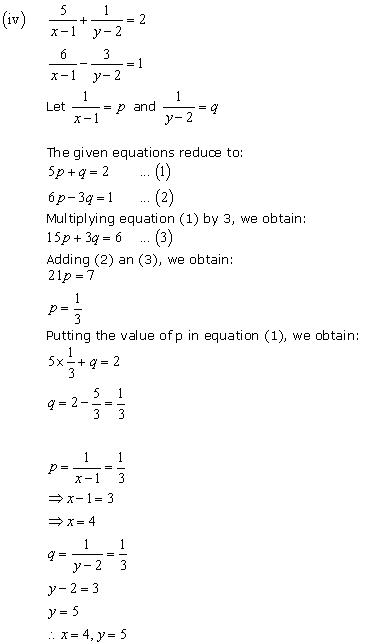
Concept insight: Here, the two given equations are not linear as the expressions on the LHS of both the equations are not linear. If we substitute
equations, then they will reduce to linear form in variables p and q. Note here that we are assuming x
 1 and y
1 and y  2. The linear equations can be solved by using any suitable algebraic method. Also, do not forget here that we need to find the values of x and y. So, put the values of p and q to find x and y.
2. The linear equations can be solved by using any suitable algebraic method. Also, do not forget here that we need to find the values of x and y. So, put the values of p and q to find x and y. 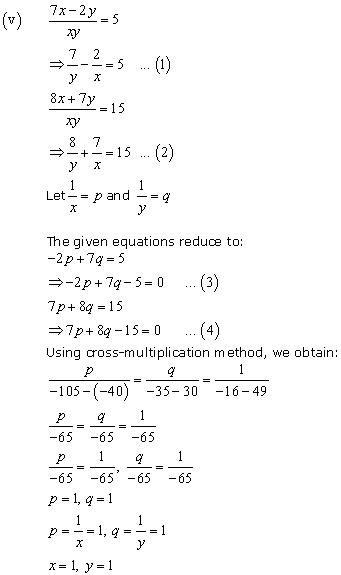
Concept insight: Here, the two given equations are not linear as the expressions on the LHS of both the equations are not linear. So, here our first step will be to break the expression on the LHS. Thereafter, if we will substitute
reduce to linear form in variables p and q. Note here that we are assuming x
 0 and y
0 and y  0. The linear equations can be solved by using any suitable algebraic method. Also, do not forget here that we need to find the values of x and y. So, put the values of p and q to find x and y.
0. The linear equations can be solved by using any suitable algebraic method. Also, do not forget here that we need to find the values of x and y. So, put the values of p and q to find x and y. 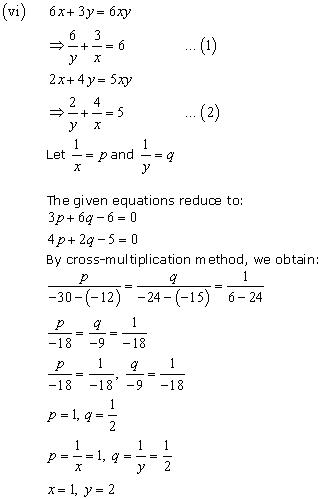
Concept insight: Here, the two given equations are not linear as the expressions on the LHS of both the equations are not linear. So, first step will be to divide both LHS and RHS by xy. Thereafter, substitute
form in variables p and q. Note here that we are assuming x
 0 and y
0 and y  0. The linear equations can be solved by using any suitable algebraic method. Also, do not forget here that we need to find the values of x and y. So, put the values of p and q to find x and y.
0. The linear equations can be solved by using any suitable algebraic method. Also, do not forget here that we need to find the values of x and y. So, put the values of p and q to find x and y. 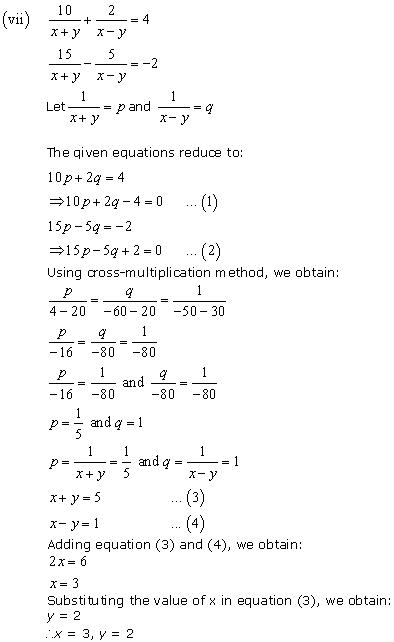
Concept insight: Here, the two given equations are not linear as the expressions on the LHS are not linear. If we substitute
reduce to linear form in variables p and q. Note here that we are assuming x + y
 0 and x - y
0 and x - y  0, otherwise the equations will not make sense. The linear equations can then be solved by using any suitable algebraic method. Also, do not forget here that we need to find the values of x and y. So, put the values of p and q and two linear equations x + y = 5 and x - y = 1 will be obtained. And these equations can be solved easily by elimination method.
0, otherwise the equations will not make sense. The linear equations can then be solved by using any suitable algebraic method. Also, do not forget here that we need to find the values of x and y. So, put the values of p and q and two linear equations x + y = 5 and x - y = 1 will be obtained. And these equations can be solved easily by elimination method. 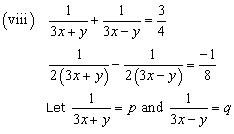
The given equations reduce to:
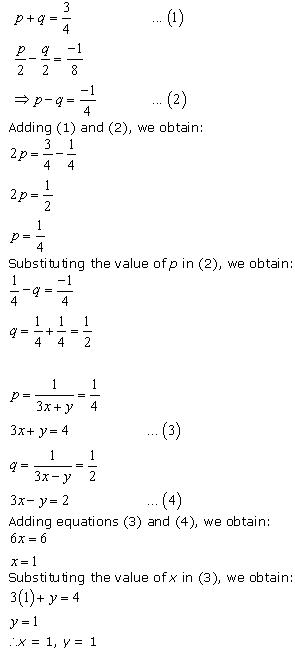
Concept insight: Here, the two given equations are not linear as the expressions on the LHS are not linear. If we substitute
reduce to linear form in variables p and q. Note here that we are assuming 3x + y
 0 and 3x - y
0 and 3x - y  0. The linear equations can be solved by using any suitable algebraic method. Also, do not forget here that we need to find the values of x and y. So, put the values of p and q to obtain two linear equations
0. The linear equations can be solved by using any suitable algebraic method. Also, do not forget here that we need to find the values of x and y. So, put the values of p and q to obtain two linear equations 3x + y = 4 and 3x - y = 2. These equations can then be solved easily by elimination method.
Question 2
Formulate the following problems as a pair of equations, and hence find their solutions:
(i) Ritu can row downstream 20 km in 2 hours, and upstream 4 km in 2 hours. Find her speed of rowing in still water and the speed of the current.
(ii) 2 women and 5 men can together finish an embroidery work in 4 days, while 3 women and 6 men can finish it in 3 days. Find the time taken by 1 woman alone to finish the work, and also that taken by 1 man alone.
(iii) Roohi travels 300 km to her home partly by train and partly by bus. She takes 4 hours if she travels 60 km by train and remaining by bus. If she travels 100 km by train and the remaining by bus, she takes 10 minutes longer. Find the speed of the train and the bus separately.
(i) Ritu can row downstream 20 km in 2 hours, and upstream 4 km in 2 hours. Find her speed of rowing in still water and the speed of the current.
(ii) 2 women and 5 men can together finish an embroidery work in 4 days, while 3 women and 6 men can finish it in 3 days. Find the time taken by 1 woman alone to finish the work, and also that taken by 1 man alone.
(iii) Roohi travels 300 km to her home partly by train and partly by bus. She takes 4 hours if she travels 60 km by train and remaining by bus. If she travels 100 km by train and the remaining by bus, she takes 10 minutes longer. Find the speed of the train and the bus separately.
Solution 2
(i) Let the speed of Ritu in still water and the speed of stream be x km/h and y km/h respectively.
Speed of Ritu while rowing upstream = (x-y) km/h
Speed of Ritu while rowing downstream = (x + y) km /h
According to the question,
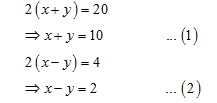
Adding equations (1) and (2), we obtain:
2x = 12
x = 6
Putting the value of x in equation (1), we obtain:
y = 4
Thus, Ritu’s speed in still water is 6 km/h and the speed of the current is 4 km/h.
Concept insight: Two unknown quantities are speed in still water and the speed of the current, which can be represented by variables x and y respectively. Then using the given conditions, two linear equations can be formed. Remember the speed while rowing upstream will be x + y and while rowing downstream, it will be x – y. Now, the two equations can be solved easily by the substitution method.
(ii) Let the number of days taken by a woman and a man to finish the work be x and y respectively.
Work done by a woman in 1 day = 

Work done by a man in 1 day = 

According to the question,
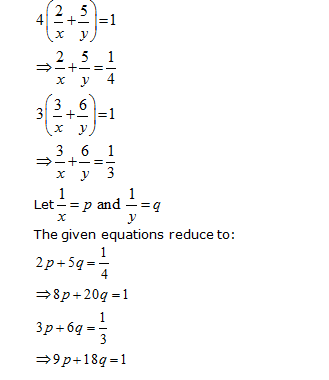
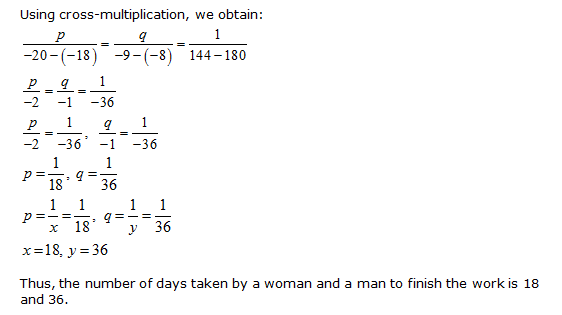

(iii) Let the speed of train and bus be u km/h and v km/h respectively.
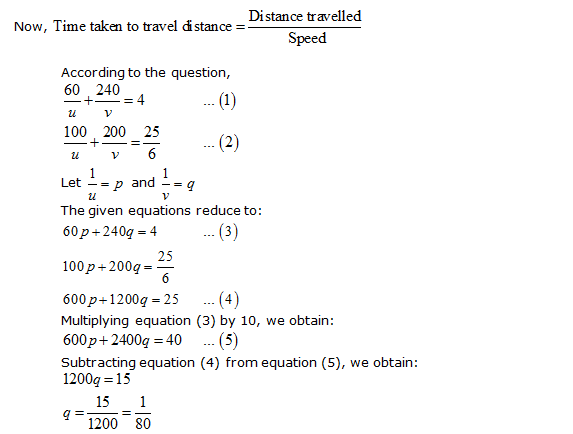
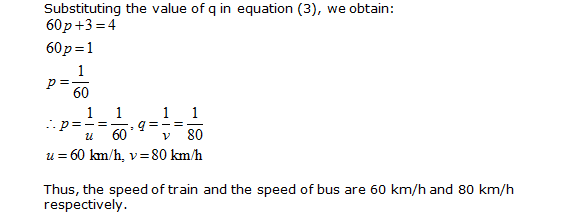
Concept insight: In this problem it is mentioned that a girl Roohi travels to her home partly by train and partly by bus. So, we represent the speed of the train and bus by variables u and v respectively. Here, to answer this problem, remember the fact that speed is the ratio of distance and time. Using this and the given conditions, formulate pair of linear equations. Observe that the equations obtained are not linear. So, first step will be to convert them into linear form by suitable substitution and then solve it using an appropriate algebraic method.
NCERT Solution for Class 10 Mathematics Chapter 3 - Pairs of Linear Equations in Two Variables Page/Excercise 3.7
Question 1
The ages of two friends Ani and Biju differ by 3 years. Ani's father Dharam is twice as old as Ani and Biju is twice as old as his sister Cathy. The ages of Cathy and Dharam differs by 30 years. Find the ages of Ani and Biju.
Solution 1
The difference between the ages of Ani and Biju is given as 3 years. So, either Biju is 3 years older than Ani or Ani is 3 years older than Biju.
Let the age of Ani and Biju be x years and y years respectively.
Age of Dharam = 2 * x = 2x years
 Case I: Ani is older than Biju by 3 years
Case I: Ani is older than Biju by 3 years
x - y = 3 ... (1)
 4x - y = 60 ... (2)
4x - y = 60 ... (2)
Subtracting (1) from (2), we obtain:
3x = 60 - 3 = 57
 Age of Ani = 19 years
Age of Ani = 19 years
Age of Biju = 19 - 3 = 16 years
Case II: Biju is older than Ani by 3 years
y - x = 3 ... (3)

4x - y = 60 ... (4)
Adding (3) and (4), we obtain:
3x = 63
x = 21
Age of Ani = 21 years
Age of Biju = 21 + 3 = 24 years
Concept Insight: In this problem, ages of Ani and Biju are the unknown quantities. So, we represent them by variables x and y. Now, note that here it is given that the ages of Ani and Biju differ by 3 years. So, it is not mentioned that which one is older. So, the most important point in this question is to consider both cases Ani is older than Biju and Biju is older than Ani. For second condition the relation on the ages of Dharam and Cathy can be implemented . Pair of linear equations can be solved using a suitable algebraic method.
Let the age of Ani and Biju be x years and y years respectively.
Age of Dharam = 2 * x = 2x years
x - y = 3 ... (1)
Subtracting (1) from (2), we obtain:
3x = 60 - 3 = 57
Age of Biju = 19 - 3 = 16 years
Case II: Biju is older than Ani by 3 years
y - x = 3 ... (3)
4x - y = 60 ... (4)
Adding (3) and (4), we obtain:
3x = 63
x = 21
Age of Ani = 21 years
Age of Biju = 21 + 3 = 24 years
Concept Insight: In this problem, ages of Ani and Biju are the unknown quantities. So, we represent them by variables x and y. Now, note that here it is given that the ages of Ani and Biju differ by 3 years. So, it is not mentioned that which one is older. So, the most important point in this question is to consider both cases Ani is older than Biju and Biju is older than Ani. For second condition the relation on the ages of Dharam and Cathy can be implemented . Pair of linear equations can be solved using a suitable algebraic method.
Question 2
One says, "Give me a hundred, friend! I shall then become twice as rich as you". The other replies, "If you give me ten, I shall be six times as rich as you". Tell me what is the amount of their (respective) capital?
Solution 2
Let the money with the first person and second person be Rs x and Rs y respectively.
According to the question,
x + 100 = 2(y - 100)
x + 100 = 2y - 200
x - 2y = - 300 ... (1)
6(x - 10) = (y + 10)
6x - 60 = y + 10
6x - y = 70 ... (2)
Multiplying equation (2) by 2, we obtain:
12x - 2y = 140 ... (3)
Subtracting equation (1) from equation (3), we obtain:
11x = 140 + 300
11x = 440
x = 40
Putting the value of x in equation (1), we obtain:
40 - 2y = -300
40 + 300 = 2y
2y = 340
y = 170
Thus, the two friends had Rs 40 and Rs 170 with them.
Concept insight: This problem talks about the amount of capital with two friends. So, we will represent them by variables x and y respectively. Now, using the given conditions, a pair of linear equations can be formed which can then be solved easily using elimination method.
According to the question,
x + 100 = 2(y - 100)
x + 100 = 2y - 200
x - 2y = - 300 ... (1)
6(x - 10) = (y + 10)
6x - 60 = y + 10
6x - y = 70 ... (2)
Multiplying equation (2) by 2, we obtain:
12x - 2y = 140 ... (3)
Subtracting equation (1) from equation (3), we obtain:
11x = 140 + 300
11x = 440
x = 40
Putting the value of x in equation (1), we obtain:
40 - 2y = -300
40 + 300 = 2y
2y = 340
y = 170
Thus, the two friends had Rs 40 and Rs 170 with them.
Concept insight: This problem talks about the amount of capital with two friends. So, we will represent them by variables x and y respectively. Now, using the given conditions, a pair of linear equations can be formed which can then be solved easily using elimination method.
Question 3
A train covered a certain distance at a uniform speed. If the train would have been 10 km/h faster, it would have taken 2 hours less than the scheduled time. And if the train were slower by 10 km/h; it would have taken 3 hours more than the scheduled time. Find the distance covered by the train.
Solution 3
Let the speed of the train be x km/h and the time taken by train to travel the given distance be t hours and the distance to travel be d km.
 Or, d = xt ... (1)
Or, d = xt ... (1)
According to the question,
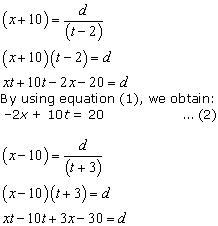
By using equation (1), we obtain:
3x - 10t = 30 ... (3)
Adding equations (2) and (3), we obtain:
x = 50
Substituting the value of x in equation (2), we obtain:
(-2) x (50) + 10t = 20
-100 + 10t = 20
10t = 120
t = 12
From equation (1), we obtain:
d = xt = 50 x 12 = 600
Thus, the distance covered by the train is 600 km.
Concept insight: To solve this problem, it is very important to remember the relation, . Now, all these three quantities are unknown. So, we will represent these by three different variables. By using the given conditions, a pair of equations will be obtained. Mind one thing that the equations obtained will not be linear. But they can be reduced to linear form by using the fact that,
. Now, all these three quantities are unknown. So, we will represent these by three different variables. By using the given conditions, a pair of equations will be obtained. Mind one thing that the equations obtained will not be linear. But they can be reduced to linear form by using the fact that,  . Then two linear equations can be formed which can be solved easily by elimination method.
. Then two linear equations can be formed which can be solved easily by elimination method.
 Or, d = xt ... (1)
Or, d = xt ... (1)According to the question,

By using equation (1), we obtain:
3x - 10t = 30 ... (3)
Adding equations (2) and (3), we obtain:
x = 50
Substituting the value of x in equation (2), we obtain:
(-2) x (50) + 10t = 20
-100 + 10t = 20
10t = 120
t = 12
From equation (1), we obtain:
d = xt = 50 x 12 = 600
Thus, the distance covered by the train is 600 km.
Concept insight: To solve this problem, it is very important to remember the relation,
 . Now, all these three quantities are unknown. So, we will represent these by three different variables. By using the given conditions, a pair of equations will be obtained. Mind one thing that the equations obtained will not be linear. But they can be reduced to linear form by using the fact that,
. Now, all these three quantities are unknown. So, we will represent these by three different variables. By using the given conditions, a pair of equations will be obtained. Mind one thing that the equations obtained will not be linear. But they can be reduced to linear form by using the fact that,  . Then two linear equations can be formed which can be solved easily by elimination method.
. Then two linear equations can be formed which can be solved easily by elimination method.
Question 4
The students of a class are made to stand in rows. If 3 students are extra in a row, there would be 1 row less. If 3 students are less in a row, there would be 2 rows more. Find the number of students in the class.
Solution 4
Let the number of rows be x and number of students in a row be y.
Total number of students in the class = Number of rows x Number of students in a row
= xy
Total number of students in the class = Number of rows x Number of students in a row
= xy
According to the question,
Total number of students = (x - 1) (y + 3)
xy = (x - 1) (y + 3)
= xy - y + 3x - 3
3x - y - 3 = 0
3x - y = 3 ... (1)
Total number of students = (x + 2) (y - 3)
xy = xy + 2y - 3x - 6
3x - 2y = -6 ... (2)
Subtracting equation (2) from (1), we obtain:
y = 9
Substituting the value of y in equation (1), we obtain:
3x - 9 = 3
3x = 9 + 3 = 12
x = 4
Number of rows = x = 4
Number of students in a row = y = 9
Total number of students in a class = xy = 4 x 9 = 36
Concept insight: This problem talks about some number of students who are made to stand in a row. So, in order to know the total number of students, it is must to know the number of students standing in each row and the total number of rows. So, these two quantities are represented by variables x and y. Use the conditions given in the question to obtain a pair of equations. The pair of equations can then be solved easily by eliminating a suitable variable.
3x - y - 3 = 0
3x - y = 3 ... (1)
Total number of students = (x + 2) (y - 3)
xy = xy + 2y - 3x - 6
3x - 2y = -6 ... (2)
Subtracting equation (2) from (1), we obtain:
y = 9
Substituting the value of y in equation (1), we obtain:
3x - 9 = 3
3x = 9 + 3 = 12
x = 4
Number of rows = x = 4
Number of students in a row = y = 9
Total number of students in a class = xy = 4 x 9 = 36
Concept insight: This problem talks about some number of students who are made to stand in a row. So, in order to know the total number of students, it is must to know the number of students standing in each row and the total number of rows. So, these two quantities are represented by variables x and y. Use the conditions given in the question to obtain a pair of equations. The pair of equations can then be solved easily by eliminating a suitable variable.
Question 5
In a  ABC,
ABC,  C = 3
C = 3 B = 2(
B = 2( A +
A +  B). Find the three angles.
B). Find the three angles.
 ABC,
ABC,  C = 3
C = 3 B = 2(
B = 2( A +
A +  B). Find the three angles.
B). Find the three angles.
Solution 5
 C = 3
C = 3 B = 2(
B = 2( A +
A +  B)
B) 3
 B = 2(
B = 2( A +
A +  B)
B)  B = 2
B = 2 A
A 2
 A -
A -  B = 0 ... (1)
B = 0 ... (1) We know that the sum of the measures of all angles of a triangle is 180°.
 A +
A +  B +
B +  C = 180°
C = 180°  A +
A +  B + 3
B + 3 B = 180°
B = 180°  A + 4
A + 4 B = 180° ... (2)
B = 180° ... (2) Multiplying equation (1) by 4, we obtain:
8
 A - 4
A - 4 B = 0 ... (3)
B = 0 ... (3) Adding equations (2) and (3), we obtain:
9
 A = 180°
A = 180°  A = 20°
A = 20° From equation (2), we obtain:
20° + 4
 B = 180° 4
B = 180° 4 B = 160°
B = 160°  B = 40°
B = 40°  C = 3
C = 3 B = 3 x 40° = 120°
B = 3 x 40° = 120° Thus, the measure of
 A,
A,  B and
B and  C are 20°, 40°, and 120° respectively.
C are 20°, 40°, and 120° respectively. Concept insight: Here the problem is about three angles of a triangle. By simplifying the given relation, a linear equation is obtained. Using the angle sum property of triangles, i.e., the sum of all the three angles of a triangle is 180° another relation is obtained. So, from these two relations, a pair of linear equations will be obtained which can be easily solved by elimination method.
Question 6
Draw the graphs of the equations 5x - y = 5 and 3x - y = 3. Determine the co-ordinates of the vertices of the triangle formed by these lines and the y axis.
Solution 6
Three solutions of this equation can be written in a table as follows:
| x | 0 | 1 | 2 |
| y | -5 | 0 | 5 |
| x | 0 | 1 | 2 |
| y | -3 | 0 | 3 |
The graphical representation of the two lines will be as follows:
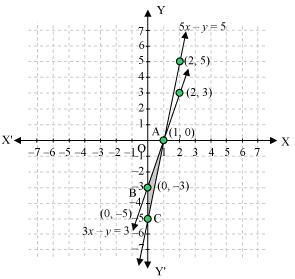
It can be observed that the required triangle is
 ABC.
ABC.The coordinates of its vertices are A (1, 0), B (0, -3), C (0, -5).
Concept insight: In order to find the coordinates of the vertices of the triangle so formed, find the points where the two lines intersects the y-axis and also where the two lines intersect each other. Here, note that the coordinates of the intersection of lines with y-axis is taken and not with x-axis, this is because the question says to find the triangle formed by the two lines and the y-axis.
Question 7
Solve the following pair of linear equations.
(i) px + qy = p - q
qx - py = p + q
(ii) ax + by = c
bx + ay = 1 + c

ax + by = a2 + b2
(iv) (a - b)x + (a + b)y = a2 - 2ab - b2
(a + b)(x + y) = a2 + b2
(v) 152x - 378y = -74
-378x + 152y = -604
(i) px + qy = p - q
qx - py = p + q
(ii) ax + by = c
bx + ay = 1 + c
ax + by = a2 + b2
(iv) (a - b)x + (a + b)y = a2 - 2ab - b2
(a + b)(x + y) = a2 + b2
(v) 152x - 378y = -74
-378x + 152y = -604
Solution 7
(i) px + qy = p - q ... (1)
qx - py = p + q ... (2)
Multiplying equation (1) by p and equation (2) by q, we obtain:
p2x + pqy = p2 - pq ... (3)
q2x - pqy = pq + q2 ... (4)
Adding equations (3) and (4), we obtain:
p2x + q2x = p2 + q2
(p2 + q2)x = p2 + q2
 Substituting the value of x in equation (1), we obtain:
Substituting the value of x in equation (1), we obtain:
p(1) + qy = p - q
qy = -q
y = -1
(ii) ax + by = c ... (1)
bx + ay = 1 + c ... (2)
Multiplying equation (1) by a and equation (2) by b, we obtain:
a2x + aby = ac ... (3)
b2x + aby = b + bc ... (4)
Subtracting equation (4) from equation (3),
(a2 - b2)x = ac - bc - b
 Substituting the value of x in equation (1), we obtain:
Substituting the value of x in equation (1), we obtain: 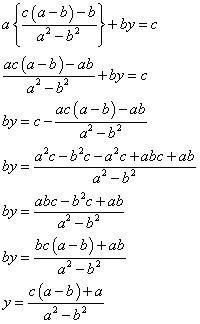
 bx - ay = 0 ... (1)
bx - ay = 0 ... (1)
ax + by = a2 + b2 ... (2)
Multiplying equation (1) and (2) by b and a respectively, we obtain:
b2x - aby = 0 ... (3)
a2x + aby = a3 + ab2 ... (4)
Adding equations (3) and (4), we obtain:
b2x + a2x = a3 + ab2
x(b2 + a2) = a(a2 + b2)
x = a
Substituting the value of x in equation (1), we obtain:
b(a) - ay = 0
ab - ay = 0
ay = ab
y = b
(iv) (a - b)x + (a + b)y = a2 - 2ab - b2 ... (1)
(a + b)(x + y) = a2 + b2

Subtracting equation (2) from (1), we obtain:
(a - b)x - (a + b)x = (a2 - 2ab - b2) - (a2 + b2)
(a - b - a - b)x = -2ab - 2b2
-2bx = -2b(a + b)
x = a + b
Substituting the value of x in equation (1), we obtain:
(a - b)(a + b) + (a + b)y = a2 - 2ab - b2
a2 - b2 + (a + b)y = a2 - 2ab - b2
(a + b)y = -2ab Concept insight: In all the above parts, the given pair of equations can be easily solved by eliminating a suitable variable. Although one can use any of the other methods but the elimination method is the best suited over here.
Concept insight: In all the above parts, the given pair of equations can be easily solved by eliminating a suitable variable. Although one can use any of the other methods but the elimination method is the best suited over here.
(v) 152x - 378y = -74 ... (1)
-378x + 152y = -604 ... (2)
Adding the equations (1) and (2), we obtain:
-226x - 226y = -678 Subtracting the equation (2) from equation (1), we obtain:
Subtracting the equation (2) from equation (1), we obtain:
530x - 530y = 530
 Adding equations (3) and (4), we obtain:
Adding equations (3) and (4), we obtain:
2x = 4 x = 2
Substituting the value of x in equation (3), we obtain:
y = 1
Concept insight: Here, since the coefficients of x and y in the two equations are interchanging this types of problems can be easily solved by once adding the given equations and then subtracting the given equations. By doing this an equation of the form x - y = a and x + y = b, where a and b are constants will be obtained. And these equations can now be solved easily by elimination method.
qx - py = p + q ... (2)
Multiplying equation (1) by p and equation (2) by q, we obtain:
p2x + pqy = p2 - pq ... (3)
q2x - pqy = pq + q2 ... (4)
Adding equations (3) and (4), we obtain:
p2x + q2x = p2 + q2
(p2 + q2)x = p2 + q2
p(1) + qy = p - q
qy = -q
y = -1
(ii) ax + by = c ... (1)
bx + ay = 1 + c ... (2)
Multiplying equation (1) by a and equation (2) by b, we obtain:
a2x + aby = ac ... (3)
b2x + aby = b + bc ... (4)
Subtracting equation (4) from equation (3),
(a2 - b2)x = ac - bc - b

ax + by = a2 + b2 ... (2)
Multiplying equation (1) and (2) by b and a respectively, we obtain:
b2x - aby = 0 ... (3)
a2x + aby = a3 + ab2 ... (4)
Adding equations (3) and (4), we obtain:
b2x + a2x = a3 + ab2
x(b2 + a2) = a(a2 + b2)
x = a
Substituting the value of x in equation (1), we obtain:
b(a) - ay = 0
ab - ay = 0
ay = ab
y = b
(iv) (a - b)x + (a + b)y = a2 - 2ab - b2 ... (1)
(a + b)(x + y) = a2 + b2
Subtracting equation (2) from (1), we obtain:
(a - b)x - (a + b)x = (a2 - 2ab - b2) - (a2 + b2)
(a - b - a - b)x = -2ab - 2b2
-2bx = -2b(a + b)
x = a + b
Substituting the value of x in equation (1), we obtain:
(a - b)(a + b) + (a + b)y = a2 - 2ab - b2
a2 - b2 + (a + b)y = a2 - 2ab - b2
(a + b)y = -2ab
(v) 152x - 378y = -74 ... (1)
-378x + 152y = -604 ... (2)
Adding the equations (1) and (2), we obtain:
-226x - 226y = -678
530x - 530y = 530
2x = 4 x = 2
Substituting the value of x in equation (3), we obtain:
y = 1
Concept insight: Here, since the coefficients of x and y in the two equations are interchanging this types of problems can be easily solved by once adding the given equations and then subtracting the given equations. By doing this an equation of the form x - y = a and x + y = b, where a and b are constants will be obtained. And these equations can now be solved easily by elimination method.
Question 8
ABCD is a cyclic quadrilateral. Find the angles of the cyclic quadrilateral.
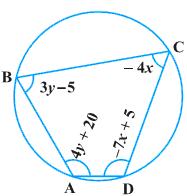

Solution 8
We know that the sum of the measures of opposite angles in a cyclic quadrilateral is 180°.
 A +
A +  C = 180
C = 180
4y + 20 - 4x = 180
-4x + 4y = 160
x - y = -40 ... (1)
Also, B +
B +  D = 180
D = 180
3y - 5 - 7x + 5 = 180
-7x + 3y = 180 ... (2)
Multiplying equation (1) by 3, we obtain:
3x - 3y = -120 ... (3)
Adding equations (2) and (3), we obtain:
-4x = 60
x = -15
Substituting the value of x in equation (1), we obtain:
-15 - y = -40
y = -15 + 40 = 25
 A = 4y + 20 = 4(25) + 20 = 120°
A = 4y + 20 = 4(25) + 20 = 120°
 B = 3y - 5 = 3(25) - 5 = 70°
B = 3y - 5 = 3(25) - 5 = 70°
 C = -4x = -4(-15) = 60°
C = -4x = -4(-15) = 60°
 D = -7x + 5 = -7(-15) + 5 = 110°
D = -7x + 5 = -7(-15) + 5 = 110°
Concept insight: The most important idea to solve this problem is by using the fact that the sum of the measures of opposite angles in a cyclic quadrilateral is 180°. By using this relation, two linear equations can be obtained which can be solved easily by eliminating a suitable variable.
 A +
A +  C = 180
C = 180 4y + 20 - 4x = 180
-4x + 4y = 160
x - y = -40 ... (1)
Also,
 B +
B +  D = 180
D = 1803y - 5 - 7x + 5 = 180
-7x + 3y = 180 ... (2)
Multiplying equation (1) by 3, we obtain:
3x - 3y = -120 ... (3)
Adding equations (2) and (3), we obtain:
-4x = 60
x = -15
Substituting the value of x in equation (1), we obtain:
-15 - y = -40
y = -15 + 40 = 25
 A = 4y + 20 = 4(25) + 20 = 120°
A = 4y + 20 = 4(25) + 20 = 120° B = 3y - 5 = 3(25) - 5 = 70°
B = 3y - 5 = 3(25) - 5 = 70° C = -4x = -4(-15) = 60°
C = -4x = -4(-15) = 60° D = -7x + 5 = -7(-15) + 5 = 110°
D = -7x + 5 = -7(-15) + 5 = 110° Concept insight: The most important idea to solve this problem is by using the fact that the sum of the measures of opposite angles in a cyclic quadrilateral is 180°. By using this relation, two linear equations can be obtained which can be solved easily by eliminating a suitable variable.
No comments:
Post a Comment